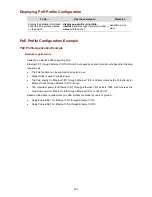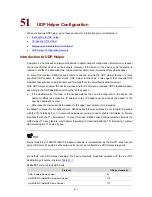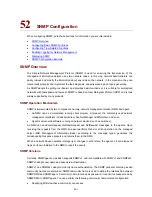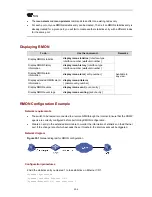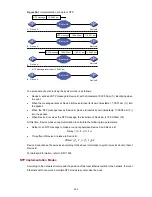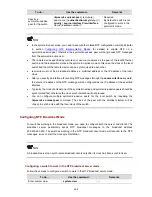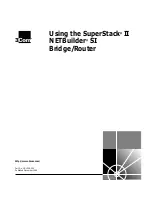
53-1
53
RMON Configuration
Wh n configuring RMON, g
e
o to these sections for information you are interested in:
N
z
Introduction to RMO
z
RMON Configuration
z
Displaying RMON
mple
z
RMON Configuration Exa
Intro
made to MIB II standards. RMON is mainly used to monitor the data traffic
etwork segments to which their ports connect,
num
cessfully sent to a specific host.
z
With RMON implemented, the communication traffic between NMS and SNMP agents can be
management of large-scale internetworks.
Work
RMO
z
perates in this way, the NMS directly
z
NMS operating in this way can only obtain the information about these four groups (instead
e total traffic, error
duction to RMON
Remote Monitoring (RMON) is a kind of MIB defined by Internet Engineering Task Force (IETF). It is an
important enhancement
across a network segment or even the entire network, and is currently a commonly used network
management standard.
An RMON system comprises of two parts: the network management station (NMS) and the agents
running on network devices. RMON agents operate on network monitors or network probes to collect
and keep track of the statistics of the traffic across the n
such as the total number of the packets on a network segment in a specific period of time and the total
ber of packets suc
z
RMON is fully based on SNMP architecture. It is compatible with the current SNMP
implementations.
z
RMON enables SNMP to monitor remote network devices more effectively and actively, thus
providing a satisfactory means of monitoring remote subnets.
reduced, thus facilitating the
ing Mechanism of RMON
N allows multiple monitors. It can collect data in the following two ways:
Using the dedicated RMON probes. When an RMON system o
obtains management information from the RMON probes and controls the network resources. In
this case, all information in the RMON MIB can be obtained.
Embedding RMON agents into network devices (such as routers, switches and hubs) directly to
make the latter capable of RMON probe functions. When an RMON system operates in this way,
the NMS collects network management information by exchanging information with the SNMP
agents using the basic SNMP commands. However, this way depends on device resources heavily
and an
of all the information in the RMON MIB): alarm group, event group, history group, and statistics
group.
A Switch 4500 implements RMON in the second way. With an RMON agent embedded in, A Switch
4500 can serve as a network device with the RMON probe function. Through the RMON-capable SNMP
agents running on the Ethernet switch, an NMS can obtain the information about th

